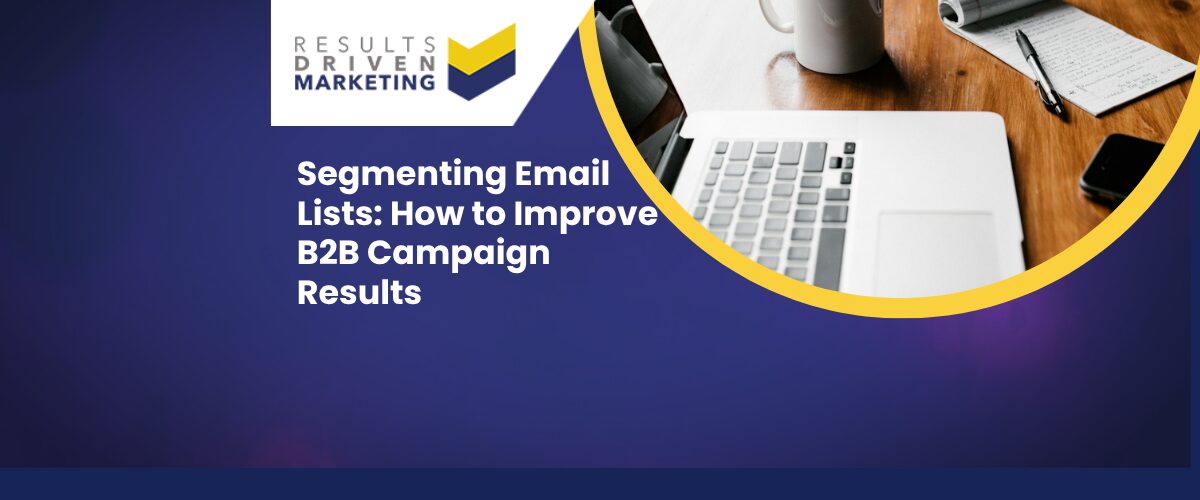
Segmenting Email Lists: How to Improve B2B Campaign Results
Segmenting email lists is one of the most important steps in creating successful B2B campaigns—yet it’s often overlooked by SMEs using purchased data. If you’ve ever sent a cold email campaign that flopped or heard crickets after a big send, segmentation (or the lack of it) is likely the culprit.
Many businesses make the mistake of treating all contacts the same. But a managing director in manufacturing doesn’t want the same message as a marketing manager in tech. When your emails are generic, your results will be too.
In this guide, we’ll show you how to break your lists into smart, simple segments that actually improve performance. Whether you’re targeting by industry, job role, region or company size, the goal is the same: more relevance, better engagement, and ultimately, more leads. You’ll leave with a clear strategy to turn your contact data into meaningful conversations—and results.
Why Segmentation Matters in B2B Email Marketing
Segmenting email lists isn’t just a nice-to-have—it’s a game-changer for B2B marketing performance. In a world where inboxes are crowded and attention spans are short, relevance is everything. The more tailored your message, the more likely it is to be opened, read, and acted on.
Here’s why segmentation is so effective:
-
Higher open rates: Subject lines that match a contact’s role or sector stand out in the inbox.
-
Better engagement: When your message speaks directly to someone’s responsibilities or challenges, they’re more likely to click, reply, or convert.
-
Stronger lead quality: Segmented campaigns attract the right people with the right offer—leading to faster sales and fewer wasted calls.
-
Improved deliverability: Irrelevant emails trigger spam complaints. Segmented campaigns are more welcomed and less likely to be flagged.
-
Better use of purchased data: Segmentation helps you extract more value from your list—turning cold contacts into warm opportunities.
The Cost of Not Segmenting Email Lists
Failing to segment your email lists doesn’t just lead to underwhelming results—it actively harms your campaign ROI, your brand reputation, and even your deliverability. If you’re sending the same message to every contact on your list, you’re leaving money—and trust—on the table.
What happens when you don’t segment:
-
Low open rates: Generic subject lines are ignored or deleted.
-
Poor engagement: Irrelevant messaging gets skimmed, not clicked.
-
Lower conversions: Your offer doesn’t match the recipient’s needs or level of authority.
-
More spam complaints: People mark your email as junk because it feels like junk.
-
Damaged sender reputation: Email providers flag you, and future emails land in spam folders—even for good prospects.
Real-World Example
Imagine emailing a “20% off software” promo to both IT managers and finance directors. One might be interested; the other might see it as irrelevant and annoying. Now multiply that across thousands of contacts.
Segmenting isn’t just about better results—it’s about avoiding bad ones. When your message misses the mark, it’s not neutral—it’s negative.
How to Segment Email Lists for B2B Success
Segmenting email lists gives you the power to personalise at scale—so every contact gets a message that feels tailored, even if it’s part of a wider campaign. Here’s how to do it effectively when targeting UK SMEs.
Industry/Sector
-
Why it matters: Each sector has unique challenges and terminology.
-
Example: A message about “improving patient scheduling” works for healthcare, but not for construction.
-
Tip: Use sector-specific benefits or examples in subject lines and email body.
Job Role or Function
-
Tailor by decision-making level: Owners and directors want ROI and strategic impact. Managers and execs want day-to-day solutions.
-
Examples:
-
Owners: “Grow revenue with faster lead response”
-
Marketing: “Boost campaign performance with better data”
-
Operations: “Improve service delivery with smart scheduling”
-
Business Size or Turnover
-
Why it matters: Larger firms often have different budgets, needs, and decision processes than micro-businesses.
-
Approach:
-
SMEs: Emphasise affordability, ease of use, speed
-
Mid-market: Highlight integration, scalability, and long-term value
-
Region or Location
-
Add local relevance: Mention regional events, local success stories, or area-specific benefits.
-
Example: “Helping Manchester-based service businesses cut costs”
By Past Interaction or Data Source
-
Differentiate messages for cold data vs. previous engagers
-
Example:
-
For a purchased list: Keep the message short, value-driven, and respectful
-
For previous responders: Reference past contact or shared context
-
Good segmentation makes your emails feel one-to-one—even when they’re not. That’s how you win attention and action in busy inboxes.
Practical Examples of High-Performing Segments
Segmenting email lists isn’t just theory—it leads to measurable improvements in campaign results. Here are some practical, real-world examples of how slight adjustments based on segmentation can significantly boost performance.
Example 1: Job Role Segmentation
Campaign A: Sent the same email to both managing directors and marketing managers
Result: Open rate = 13%, reply rate = 0.5%
Campaign B: Split the list and rewrote messaging for each role
-
Managing directors: Focused on revenue growth and strategic ROI
-
Marketing managers: Focused on campaign performance and lead quality
Result: Open rate = 27%, reply rate = 3.2%
Example 2: Industry Segmentation
Campaign A: One generic message to all industries
Campaign B: Three tailored versions (finance, logistics, professional services)
-
Each referenced specific problems and sector language
Result: 2x higher open rates and 3x higher click-throughs across all variants
Example 3: Regional Segmentation
Campaign A: National message
Campaign B: Split into North vs. South, referencing local case studies
Result: More replies and greater trust, especially when follow-up calls matched region
These examples prove that small tweaks in language and positioning—based on segmentation—can create big jumps in campaign performance.
How to Build Segmentation Into Your Outreach Process
Segmenting email lists only works if it’s built into your outreach process from the start—not bolted on as an afterthought. Here’s how to set up segmentation so it becomes a natural, repeatable part of every campaign.
Start With the Right Data
-
Request segmentation options upfront when purchasing B2B data
-
Ask for fields like: job title, industry, turnover, location, and number of employees
-
Work with suppliers (like us) who offer tailored, campaign-ready lists based on your targeting goals
Organise Your List for Easy Filtering
-
Use Excel or CRM filters to separate data by your chosen segments
-
Label each contact by segment (e.g. “Tech – Owner – London”)
-
Create saved views or smart lists for faster future access
Align Messaging to Segments
-
Prepare 2–3 variations of each email template based on top-level segments
-
Keep core structure the same, but adjust subject lines, benefits, and CTAs
Match Campaign Cadence to Contact Type
-
Cold data: Space emails 5–7 days apart with low-pressure CTAs
-
Warm data: Follow up more frequently with contextual reminders
Automate Where Possible
-
Use email platforms or simple mail merge tools to personalise at scale
-
But don’t overcomplicate—relevance always beats tech
Why Choose Results Driven Marketing
If you’re serious about segmenting email lists to get better campaign results, your success starts with the quality and structure of your data. At Results Driven Marketing, we specialise in helping UK SMEs do email outreach right—starting with properly segmented, accurate B2B lists.
Here’s why clients trust us:
-
12+ years in B2B data supply for UK businesses across 2,000+ sectors
-
Fast turnaround: Campaign-ready lists delivered within 24 hours in Excel or CSV
-
Precision targeting: Segment by job title, industry, region, turnover, or employee size
-
GDPR-compliant and CTPS-checked for peace of mind and legal clarity
-
Tailored advice: We don’t just send you a file—we help you plan your outreach properly
Whether you need 500 contacts or 50,000, we’ll help you build segmented campaigns that get attention and drive results.
Contact us to request a quote or speak to a data specialist about your targeting needs.
Final Thoughts: Smarter Segmentation = Better Results
Segmenting email lists is one of the most effective ways to turn cold contacts into real conversations—and real customers. Whether you’re emailing a managing director in logistics or a marketing lead in tech, the more your message speaks to them, the more likely they are to respond.
Key Takeaways:
-
Segmentation improves relevance, engagement, and ROI
-
Avoid one-size-fits-all messaging—it weakens trust and response
-
Start simple: segment by job role, industry, size, or region
-
Build segmentation into your campaign process from the start
-
Work with data partners who understand targeting, not just databases
Ready to build smarter, more profitable campaigns?
Contact us today to request a free quote or get a campaign-ready, segmented list within 24 hours.
Or if you want to learn more about how we support effective outreach, explore our email lists page.
Results Driven Marketing
Accurate, segmented B2B data for email campaigns that convert
📍 Cobalt Business Exchange, Newcastle
📞 0191 406 6399
🌐 www.rdmarketing.co.uk





